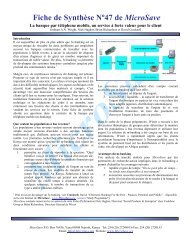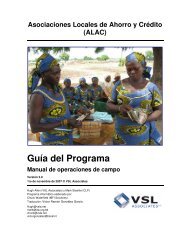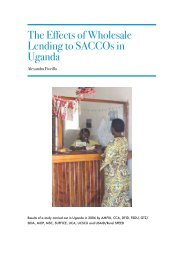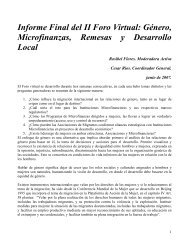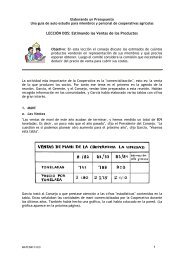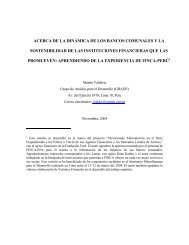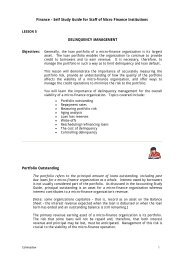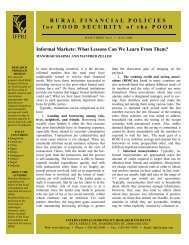review of warehouse receipt system and inventory credit initiatives in ...
review of warehouse receipt system and inventory credit initiatives in ...
review of warehouse receipt system and inventory credit initiatives in ...
Create successful ePaper yourself
Turn your PDF publications into a flip-book with our unique Google optimized e-Paper software.
Kenya<br />
Background: Kenya has around 40 million <strong>in</strong>habitants, <strong>and</strong> its ma<strong>in</strong> food crops are maize<br />
(production around 3 million tonnes accord<strong>in</strong>g to FAOSTAT) <strong>and</strong> sugar cane (5.2 million<br />
tonnes), while pulses (600,000 tonnes), wheat (350,000 tonnes) <strong>and</strong> potatoes (about 1 million<br />
tonnes) are also significant. The ma<strong>in</strong> export cash crops are c<strong>of</strong>fee, tea <strong>and</strong> fresh vegetables.<br />
Kenya is generally deficit <strong>in</strong> maize <strong>and</strong> beans, <strong>and</strong> supplements domestic supplies with<br />
imports from Tanzania <strong>and</strong> Ug<strong>and</strong>a. When the maize deficit exceeds 300,000 tonnes or<br />
thereabouts, it normally imports from countries further afield, notably South Africa.<br />
The post-election violence <strong>of</strong> early 2008 <strong>and</strong> high fertiliser prices dur<strong>in</strong>g the same year<br />
greatly depressed maize production <strong>in</strong> the gra<strong>in</strong> basket <strong>of</strong> Western Kenya, <strong>and</strong> the deficit has<br />
had to be filled by imports exceed<strong>in</strong>g 1.2 million tonnes between November 2008 <strong>and</strong> July<br />
2009. There has also been a reduction <strong>in</strong> maize consumption adversely affect<strong>in</strong>g nutrition.<br />
Government is expect<strong>in</strong>g a similar large deficit <strong>in</strong> 2009/10 due to ra<strong>in</strong> failure.<br />
Attempts to establish a regulated WRS have focused on maize, which has a less organised<br />
market than the ma<strong>in</strong> export crops, <strong>and</strong> is ma<strong>in</strong>ly produced by smallholders. Most maize<br />
goes for direct human consumption, about one third <strong>of</strong> this be<strong>in</strong>g processed by large-scale<br />
roller mills, ma<strong>in</strong>ly for consumption by better-<strong>of</strong>f urban consumers, while small-scale posho<br />
mills (decorticators + hammer mills) h<strong>and</strong>le the rest.<br />
TABLE 1: RECORDED MAIZE & BEAN EXPORTS TO KENYA & RWANDA<br />
<strong>in</strong> ‘000 tonnes<br />
Crop from to 2004 2005 2006 2007 2008<br />
Maize<br />
Beans<br />
Ug<strong>and</strong>a Kenya<br />
Tanzania Kenya<br />
Ug<strong>and</strong>a Rw<strong>and</strong>a<br />
Ug<strong>and</strong>a Kenya<br />
Tanzania Kenya<br />
76<br />
89<br />
10<br />
54<br />
2<br />
125<br />
77<br />
32<br />
77<br />
9<br />
161<br />
55<br />
33<br />
128<br />
9<br />
85<br />
121<br />
56<br />
57<br />
8<br />
Average<br />
53 100<br />
85 85<br />
74 41<br />
107 84<br />
3 6<br />
Source: RATIN trade <strong>in</strong>formation service; this captures a large part, but not the totality, <strong>of</strong> the (ma<strong>in</strong>ly<br />
<strong>in</strong>formal) trade flows concerned<br />
30




